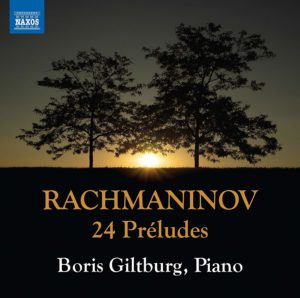From his initial Naxos release up through the present Rachmaninov Preludes collection, Boris Giltburg has proved to be an interpreter with obvious technical gifts and frustrating musical limitations. He sings out the C-sharp minor Prelude’s tolling opening section elegantly, but overshoots the central episode’s triplet chord peroration with poor melodic articulation. Problems persist throughout the Op. 23 group, abetted by the diffuse acoustic of the Wyastone Estate (home of Nimbus’ notoriously “swimmy” Ambisonic piano recordings from the 1980s).
Giltburg glibly glides through No. 1’s climax, whereas his contemporary rival Claire Huangci takes her time bringing the rising chromatic counterline into clear structural focus. In the B-flat major Prelude Giltburg makes beautiful sounds in his flexibly shaped central section, but the climactic chords lack direction and rhythmic impetus when measured next to the powerful Richter and Gavrilov reference versions. Giltburg undermines the D minor Prelude’s hybrid march/minuet character with arch tenutos and stresses that grow increasingly predictable, in contrast to the stronger left hand presence and biting accents distinguishing Eldar Nebolsin’s altogether superior Naxos Rachmaninov Preludes cycle from 2007.
The sublimely lyrical No. 4 is superficially pretty, yet Giltburg doesn’t reveal how the interweaving lines converse between registers to generate palpable harmonic tension and release. Yara Bernette’s DG recording emphatically does, and although she requires five minutes to Giltburg’s four, she actually sounds faster. For all of No. 5’s extroverted thrust, Giltburg’s ritard at the main section’s chordal climax totally misses the point. And his diminuendos in the swirling C minor serve no purpose beyond trying to find something clever to do.
Giltburg fares better in Op. 32, once past his spongy, effects-driven, and hardly scintillating rendition of the opening C major salvo. Once Giltburg settles into No. 2’s basic pulse, he locks into the music’s gentle lull. And when Giltburg decides to get out of his own way, he really delivers the goods, demonstrated by the orchestral aura and rhythmic aplomb in Nos. 3 and 4, and in the brooding B minor’s eloquently unfolding narrative. On the other hand, the familiar G-sharp minor’s undermined climaxes and overly sectionalized detailing unfavorably contrast to Horowitz’s shapeliness and canny sense of transition. The crux of the matter is that Giltburg does not seem to organize and scale his dynamics with care, forethought, and structural awareness, and I’ve also noticed this liability in the pianist’s earlier releases. Perhaps the time has come for some coaching?
































